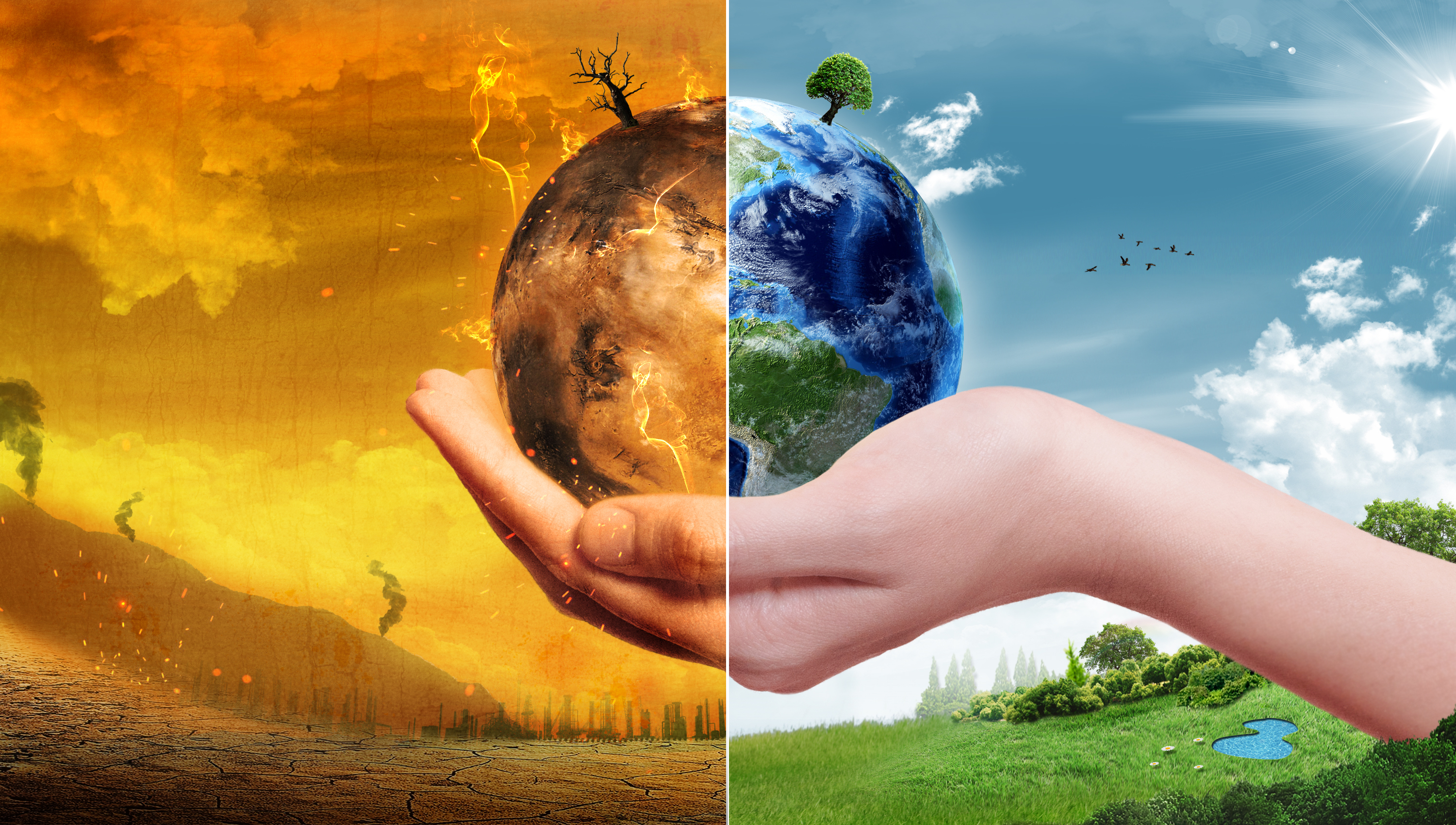Global warming is a scientific theory or scenario in which increased levels of atmospheric carbon dioxide (CO2) and other greenhouse gases are linked to general rising of temperature around the world. It should be stated that atmosphere and, in some regions primarily in the Northern hemisphere, aerosols to cool the atmosphere.
In recent years, global warming has become an increasingly pressing concern for our planet and its inhabitants. The Earth’s climate is changing at an unprecedented rate, primarily due to human activities. This blog post aims to provide an overview of what global warming is, its causes, the effects it has on our planet, and potential solutions to mitigate its impact.
What is Global Warming?
Global warming refers to the long-term increase in Earth’s average surface temperature, primarily caused by the buildup of greenhouse gases (GHGs) in the atmosphere. These gases, such as carbon dioxide (CO2) and methane (CH4), trap heat from the sun and prevent it from escaping back into space, resulting in a warming effect on the planet.
⇒Join us on Telegram for more Sure and Accurate football-winning tips every day...click here
Causes of Global Warming: Human activities are the main contributors to global warming. The burning of fossil fuels, such as coal, oil, and natural gas, releases large amounts of CO2 into the atmosphere. Deforestation also plays a significant role, as trees absorb CO2 and their removal reduces the Earth’s capacity to regulate the balance of greenhouse gases. Additionally, industrial processes, agricultural activities, and land-use changes release other potent GHGs like methane and nitrous oxide.
Effects of Global Warming: Global warming has wide-ranging consequences for both the environment and human societies. Rising temperatures lead to the melting of glaciers and polar ice, causing a rise in sea levels. This results in coastal erosion, increased frequency and intensity of storms, and the potential displacement of millions of people living in low-lying areas. Furthermore, changing weather patterns can lead to more frequent and severe heatwaves, droughts, floods, and wildfires, adversely affecting ecosystems, agriculture, and water resources.
Global warming also impacts biodiversity, as many species struggle to adapt to rapidly changing conditions. Coral reefs, for instance, are highly sensitive to temperature changes, and their bleaching and degradation have significant implications for marine life. Additionally, warmer oceans contribute to the intensification of hurricanes and the disruption of marine ecosystems, leading to a decline in fish populations.
The concept of global warming and greenhouse effect
The glass-rooted structures in which plants are grown is called a greenhouse. Usually the walls are also made of glass. A greenhouse creates an artificial environment by careful air quality, soil moisture and eat levels.
The green windows of greenhouse allows in sunlight. The sunlight warms up objects inside the greenhouse. This object them give off heat. The glass of the greenhouse, however, does not let out the heat. If the greenhouse lacks ventilation, also the heat stays locked inside and the temperature rises. The greenhouse effect also account for a fact that the inside of a car becomes hot if its windows are wind up in a sunny day.
The earth and its atmosphere are like a giant greenhouse. Like the glass window of a greenhouse, the atmosphere is nearly transparent to show waves and visible solar radiation. Part of the energy absorbed on the earth is radiated to the atmosphere as long wave infra-red radiation. Because it contains carbon dioxide and water vapour, it absorb much of the long wave radiation before partial radiation back the surface of the earth. This cause the earth and the atmosphere warm which had remained nearly constant until 20th century, when the burning of fossil fuels, such as coal, fuel, oil, petrol, kerosene, diesel and natural gas began to release large quantities of carbon dioxide into the atmosphere.
The combustion of fossil fuel has brought about and over increasing rise in the carbon dioxide concentration in the atmosphere.
The repaid eradication of the tropical rain forest is depleting the earth’s plant growth and diminishing their capability for absorbing carbon dioxide.
The unabsorbed carbon dioxide rises to the upper atmosphere and blocks the radiation of solar energy back into the space. This precipitates a global temperature increase called ‘greenhouse effect’ which scientists say is causing the ice cape to melt.
Greenhouse Gases
- Sulphur dioxide and oxide nitrogen: coal and oil containing Sulphur, when these fuels are burned, they release Sulphur dioxide (S02) into the atmosphere. The Sulphur dioxide dissolved in rain water and forms an acid. When this acid falls on plants, it reduce their growth and damage their leaves.
- Carbon monoxide: is a product of combusting in the engines of cars and trucks.
- Carbon dioxide: is given off when we burn fossil fuels like coal and oil. Its build-up in the atmosphere is contributing to the greenhouse effect.
- Nitrogen oxide: these consist of No, No2 they are collective known as NO2. They are produced naturally in nitrogen cycle, but also by car/vehicle exhaust and power plants.
- Methane gases: Also contribute to greenhouse effect. It is produced naturally from various sources e.g. natural marshland. The two sources which are on the increase are: rice growing and cattle reaing.
- Lead: Compounds of lead are mixed with petrol to improve the performance of motor cars. The lead is expelled with the exhaust gases into the air. In some areas of heavy traffic, it may reach levels which are dangerous even to human health.
- Chlorofluorocarbons (CFCS): Are used in spraying cars, refrigerators and in making plastic foams; because they are readily liquefied when compressed. Chlorofluorocarbon are very stable accumulate in the atmosphere, where they react with ozone (O3).
Ozone is present throughout the atmosphere but reaches a peak at about 25km. where it forms what is called the ‘Ozone layer’. This layer filters out mush of the ultraviolet radiation in sunlight.
The chlorine from CFCS reacts with ozone and reduces its concentration in the ozone layer. As a result, more ultraviolet (uv) radiation reaches the earth’s surface.
CONSEQUENCES OF GLOBAL WARMING

Scientist now agree that the earth has indeed heated up. The 2001 I.P.P.C. (Integrated Pollution prevention and control) report says “global surface temperature has increased between 0.4-0.80c.
Since the late 20th century. Many researchers believed that this rise account for the dramatic changes in our weather”. As a result of global warming. There has been increased rainfall in the northern Hemisphere, draught in Asia and Africa, and escalating El – Nino even on the pacific.
OTHER CONSEQUENCES THAT MAY EMERGE INCLUDE:
- Change in food production: this can increase in some areas and drop in others. Current climate models project 10-70% decline in the global yield of key food crop and a loss in current land area of 10-50% especially in most poor countries.
- Change in the makeup and location of many of the world’s forests: forest in temperate and subarctic region of the world would witness some changes that can result to more grassland and shrubland.
- Reduction in water supply in some areas: lakes, streams, and aquifers in some areas that have provided water to ecosystems, croplands and cities for centuries could shrink or dry up altogether. This would force the entire population to migrate to areas with adequate water supplies-if they could
- Reduction in biodiversity: large-scale forest diebacks would cause mass extinction of plant and animals species that cannot migrate to new areas. Fishes would die at the temperature soared in streams and lakes and as lowered water level concentrates pesticides.
- Expansion of oceans: this would lead to rise in sea level. Even the modest rise of 48centimeters project to occur by 2100 would flood coastal region- where about one-third of the world’s people and activities take place. Most coral reefs would be destroyed, barrier islands would be moved farther inlands, coastal would be accelerated, coastal aquifers would be contaminated with salt water; there would be a decline in global fish catch.
The warming at the pole will cause ice sheets and glaciers to melt even partially, the global sea level would rise the more.
- Weather extreme would increase: extreme weather would increase in number and severity. Prolonged heat waves and droughts could become the norm in many areas, taking a large fall on many humans and ecosystem.
As the upper layer of sea waters warm, damaging hurricanes, typhoons, tornados and violent storms will increase in intensity and occur more frequently
- Health problem: according to the 1995 international panel of climate change (IPPC) report, global warming would cause more heat waves. This would double heat related death among the elderly and people with heart diseases. The spread of warmer and wetter tropical climate from the equator would bring malaria enaphalities, yellow fever, and other insect borne disease to formerly temperate zone.
- Warming of the atmosphere can also affect the respiratory tract by increasing air pollution in winter months and increase exposure to dusts, pollens and smog in summer months.
CONTROL OF GLOBAL WARMING
Since global warming is a global problem, a solution would have to be global.
In 1992, the earth summit in Rio de Janeiro was convened. The years later in Johannesburg, south Africa, The world summit on sustainable development was held. Some 40,000 delegates attended this meeting in 2002, including about 100 national leaders.
- Cutting current use of fossil fuel:
160 countries signed the 1997 kyoto protocol, which require industrial nations to reduce their greenhouse emissions between the year 2008 and 2012. As weak as the treaty appears, it continues to generate controversies among governments of nations especially between the U.S.A. and Japan. Since the U.S.A. senate has not even considered ratifying the treaty, and the George W. Bush administration them was anti-fossil cut, the Japanese Government also decided (in July 2001) that she will not ratify the Kyoto protocol.
- Placing heavy axes on gasoline and emission on each unit of fossil (especially coal) burned to reduce emission of carbon dioxide and other air pollution some of the tax revenue should be used to improve the energy efficiency of dwelling and heating systems for the poor in developed countries and less developed countries and provide them with enough energy to offset fuel prices.
- Reduction in the use of coal which emits 60% more carbon dioxide per unit of energy production than any other fossil. Using the world’s estimated coal supplies would produce at least a six-fold or eight-fold I crease in atmospheric carbon dioxide.
- Shifting to perpetual and renewable energy resources that do not emit co2 over the next 20-30 years. Ultimately, the world must move away from fossil fuel for most of its energy. Even if we cut carbon dioxide emission into half. Otherwise, emission would begin to rise because of increase in population and industrialization.
- Slowing population growth: if we cut greenhouse gas emission into half, and population double, we are back to where we started. Thus family planning methods must be popularized and applied especially in countries with high illiteracy rate and poverty.
- Planting of trees: everyone should plant and care for at least to trees every year. This is an important of the earth care. This will also show carbon dioxide emission. Trees must be continually planted faster than they are cut down and burned or die and rot as both processes releases carbon dioxide into the atmosphere.
- Recycling carbon dioxide released during industrial processes
- Banning and construction of low-lying coastal areas: this should be enforced strictly especially lekki on the Victoria Island of Lagos State, Nigeria, where several hectares of wetland have been used for construction of houses.
- Educate people on harmful effects of global warming.
Solutions to Global Warming: Addressing global warming requires a collective effort from individuals, governments, and industries. Here are some key solutions:
- Transition to Renewable Energy: Shifting from fossil fuels to renewable energy sources, such as solar, wind, and hydroelectric power, can significantly reduce greenhouse gas emissions.
- Energy Efficiency: Improving energy efficiency in buildings, transportation, and industrial processes helps reduce the demand for energy and subsequently decreases carbon emissions.
- Reforestation and Forest Conservation: Protecting existing forests and undertaking reforestation efforts can help absorb CO2 from the atmosphere, mitigating global warming.
- Sustainable Agriculture: Promoting sustainable farming practices, such as precision agriculture, organic farming, and agroforestry, reduces emissions from the agricultural sector while improving soil health.
- International Cooperation: Encouraging international agreements and collaborations, such as the Paris Agreement, fosters a unified approach to combating global warming and encourages nations to set and achieve emissions reduction targets.
- Public Awareness and Education: Raising awareness about global warming and its consequences is crucial in driving individual and collective action to reduce emissions, promote sustainable practices, and support policy changes.
Conclusion:
Global warming poses a significant threat to our planet and its inhabitants. Understanding its causes, effects, and potential solutions is essential for effectively addressing this urgent global issue. By adopting sustainable practices, transitioning to renewable energy sources, and working together at local, national, and international levels, we can mitigate the impact of global warming and ensure a healthier, more sustainable future for generations to come.




